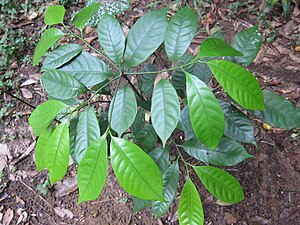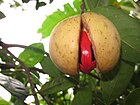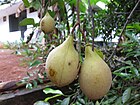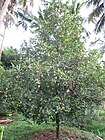Note: This is a project under development. The articles on this wiki are just being initiated and broadly incomplete. You can Help creating new pages.
Difference between revisions of "Myristica fragrans - Mayaphala"
(→References) |
|||
| Line 3: | Line 3: | ||
==Uses== | ==Uses== | ||
| − | {{Uses|Bleeding piles}}, {{Uses|Rectal bleeding}}, {{Uses|Irritable bowel syndrome}}, {{Uses|Liver disorders}}, {{Uses|Rectal prolapse}}, {{Uses|Uterine prolapse}}, {{Uses|Leucorrhea}}, {{Uses|Vaginitis}}, {{Uses|Toothache}} | + | {{Uses|Bleeding piles}}, {{Uses|Rectal bleeding}}, {{Uses|Irritable bowel syndrome}}, {{Uses|Liver disorders}}, {{Uses|Rectal prolapse}}, {{Uses|Uterine prolapse}}, {{Uses|Leucorrhea}}, {{Uses|Vaginitis}}, {{Uses|Toothache}}, {{Uses|Headache}}, {{Uses|Dysentery}}, {{Uses|Pimples}}, {{Uses|Cracked foot}}, {{Uses|Impotence}}, {{Uses|Toothache}}, {{Uses|Insomnia}}, {{Uses|Cough}}<ref name="Karnataka Medicinal Plants"/>. |
==Parts Used== | ==Parts Used== | ||
| − | {{Parts Used|Leaves}}. | + | {{Parts Used|Leaves}}, {{Parts Used|Jakayi}}<ref name="Karnataka Medicinal Plants"/>. |
==Chemical Composition== | ==Chemical Composition== | ||
| Line 12: | Line 12: | ||
==Common names== | ==Common names== | ||
| − | {{Common names|kn=ಜಾಕಾಯಿ Jakayi, ಜಾತೀಫಲ Jatiphala |ml=Majakaanee, Mashikkay|sa=Mayaphala, Majuphul|ta=Machakaai, Masikki|te=Machikaaya|hi=Maajoophal, Majuphal|en=Oak Galls, Magic Nuts}} | + | {{Common names|kn=ಜಾಕಾಯಿ Jakayi, ಜಾತೀಫಲ Jatiphala |ml=Majakaanee, Mashikkay|sa=Mayaphala, Majuphul|ta=Machakaai, Masikki|te=Machikaaya|hi=Maajoophal, Majuphal|en=Oak Galls, Magic Nuts}}<ref name="Karnataka Medicinal Plants"/> |
==Properties== | ==Properties== | ||
| Line 38: | Line 38: | ||
===Flower=== | ===Flower=== | ||
| − | {{Flower|Unisexual||Yellow|9-12|Male flowers: 3-5 in axillary cymes, urceolate; pedicels drooping; bracts deciduous; bracteoles persistent}} | + | {{Flower|Unisexual||Yellow|9-12|Male flowers: 3-5 in axillary cymes, urceolate; pedicels drooping; bracts deciduous; bracteoles persistent. Flowering from June to September}} |
===Fruit=== | ===Fruit=== | ||
| − | {{Fruit|Fleshy capsule|5 cm||Aril red, lacinate; seed brown|}} | + | {{Fruit|Fleshy capsule|5 cm||Aril red, lacinate; seed brown|Fruiting from June to September}} |
===Other features=== | ===Other features=== | ||
| Line 75: | Line 75: | ||
==References== | ==References== | ||
| − | |||
<references> | <references> | ||
<ref name="chemical composition">[https://www.ayurtimes.com/quercus-infectoria-manjakani-majuphal-benefits-uses-side-effects/ Phytochemistry]</ref> | <ref name="chemical composition">[https://www.ayurtimes.com/quercus-infectoria-manjakani-majuphal-benefits-uses-side-effects/ Phytochemistry]</ref> | ||
| Line 83: | Line 82: | ||
<ref name="How to plant/cultivate">[http://tropical.theferns.info/viewtropical.php?id=Myristica+fragrans CULTIVATION PRACTICES]</ref> | <ref name="How to plant/cultivate">[http://tropical.theferns.info/viewtropical.php?id=Myristica+fragrans CULTIVATION PRACTICES]</ref> | ||
| + | |||
| + | <ref name="Karnataka Medicinal Plants">”Karnataka Medicinal Plants Volume-3” by Dr.M. R. Gurudeva, Page No.470, Published by Divyachandra Prakashana, #6/7, Kaalika Soudha, Balepete cross, Bengaluru</ref> | ||
</references> | </references> | ||
Revision as of 16:49, 10 January 2022
Quercus infectoria is a species of oak, bearing galls that have been traditionally used for centuries in Asia medicinally. Quercus infectoria or locally known as Manjakani in Malaysia
Contents
- 1 Uses
- 2 Parts Used
- 3 Chemical Composition
- 4 Common names
- 5 Properties
- 6 Habit
- 7 Identification
- 8 List of Ayurvedic medicine in which the herb is used
- 9 Where to get the saplings
- 10 Mode of Propagation
- 11 How to plant/cultivate
- 12 Commonly seen growing in areas
- 13 Photo Gallery
- 14 References
- 15 External Links
Uses
Bleeding piles, Rectal bleeding, Irritable bowel syndrome, Liver disorders, Rectal prolapse, Uterine prolapse, Leucorrhea, Vaginitis, Toothache, Headache, Dysentery, Pimples, Cracked foot, Impotence, Toothache, Insomnia, Cough[1].
Parts Used
Chemical Composition
Gallic Acid & Tannic Acid are found in Manjakani[2]
Common names
| Language | Common name |
|---|---|
| Kannada | ಜಾಕಾಯಿ Jakayi, ಜಾತೀಫಲ Jatiphala |
| Hindi | Maajoophal, Majuphal |
| Malayalam | Majakaanee, Mashikkay |
| Tamil | Machakaai, Masikki |
| Telugu | Machikaaya |
| Marathi | NA |
| Gujarathi | NA |
| Punjabi | NA |
| Kashmiri | NA |
| Sanskrit | Mayaphala, Majuphul |
| English | Oak Galls, Magic Nuts |
Properties
Reference: Dravya - Substance, Rasa - Taste, Guna - Qualities, Veerya - Potency, Vipaka - Post-digesion effect, Karma - Pharmacological activity, Prabhava - Therepeutics.
Dravya
Rasa
Kashaya (Astringent)
Guna
Laghu (Light), Ruksha (Dry)
Veerya
Sheeta (cold)
Vipaka
Katu (Pungent)
Karma
Kapha, Pitta
Prabhava
Habit
Identification
Leaf
| Kind | Shape | Feature |
|---|---|---|
| Simple | Alternate | Estipulate; petiole 9-15 mm long, slender, grooved above, glabrous; lamina 9-18 x 2.5-6 cm, elliptic |
Flower
| Type | Size | Color and composition | Stamen | More information |
|---|---|---|---|---|
| Unisexual | Yellow | 9-12 | Male flowers: 3-5 in axillary cymes, urceolate; pedicels drooping; bracts deciduous; bracteoles persistent. Flowering from June to September |
Fruit
| Type | Size | Mass | Appearance | Seeds | More information |
|---|---|---|---|---|---|
| Fleshy capsule | 5 cm | Aril red, lacinate; seed brown | Fruiting from June to September | {{{6}}} |
Other features
List of Ayurvedic medicine in which the herb is used
Where to get the saplings
Mode of Propagation
How to plant/cultivate
Seed - best sown when fresh. Germination usually takes place in 5 - 6 weeks. Seed in the shell takes some 4 - 6 weeks to germinate.[5]
Commonly seen growing in areas
Evergreen forest, Western ghats
Photo Gallery
References
- ↑ 1.0 1.1 1.2 ”Karnataka Medicinal Plants Volume-3” by Dr.M. R. Gurudeva, Page No.470, Published by Divyachandra Prakashana, #6/7, Kaalika Soudha, Balepete cross, Bengaluru
- ↑ Phytochemistry
- ↑ Morphology
- ↑ Ayurvedic preparations
- ↑ CULTIVATION PRACTICES
External Links
- Ayurvedic Herbs known to be helpful to treat Bleeding piles
- Ayurvedic Herbs known to be helpful to treat Rectal bleeding
- Ayurvedic Herbs known to be helpful to treat Irritable bowel syndrome
- Ayurvedic Herbs known to be helpful to treat Liver disorders
- Ayurvedic Herbs known to be helpful to treat Rectal prolapse
- Ayurvedic Herbs known to be helpful to treat Uterine prolapse
- Ayurvedic Herbs known to be helpful to treat Leucorrhea
- Ayurvedic Herbs known to be helpful to treat Vaginitis
- Ayurvedic Herbs known to be helpful to treat Toothache
- Ayurvedic Herbs known to be helpful to treat Headache
- Ayurvedic Herbs known to be helpful to treat Dysentery
- Ayurvedic Herbs known to be helpful to treat Pimples
- Ayurvedic Herbs known to be helpful to treat Cracked foot
- Ayurvedic Herbs known to be helpful to treat Impotence
- Ayurvedic Herbs known to be helpful to treat Insomnia
- Ayurvedic Herbs known to be helpful to treat Cough
- Herbs with Leaves used in medicine
- Herbs with Jakayi used in medicine
- Herbs with common name in Kannada
- Herbs with common name in Hindi
- Herbs with common name in Malayalam
- Herbs with common name in Tamil
- Herbs with common name in Telugu
- Herbs with common name in Sanskrit
- Herbs with common name in English
- Habit - Shrub
- Index of Plants which can be propagated by Seeds
- Index of Plants which can be propagated by Cuttings
- Herbs that are commonly seen in the region of Evergreen forest
- Herbs that are commonly seen in the region of Western ghats
- Herbs
- Myristicaceae








